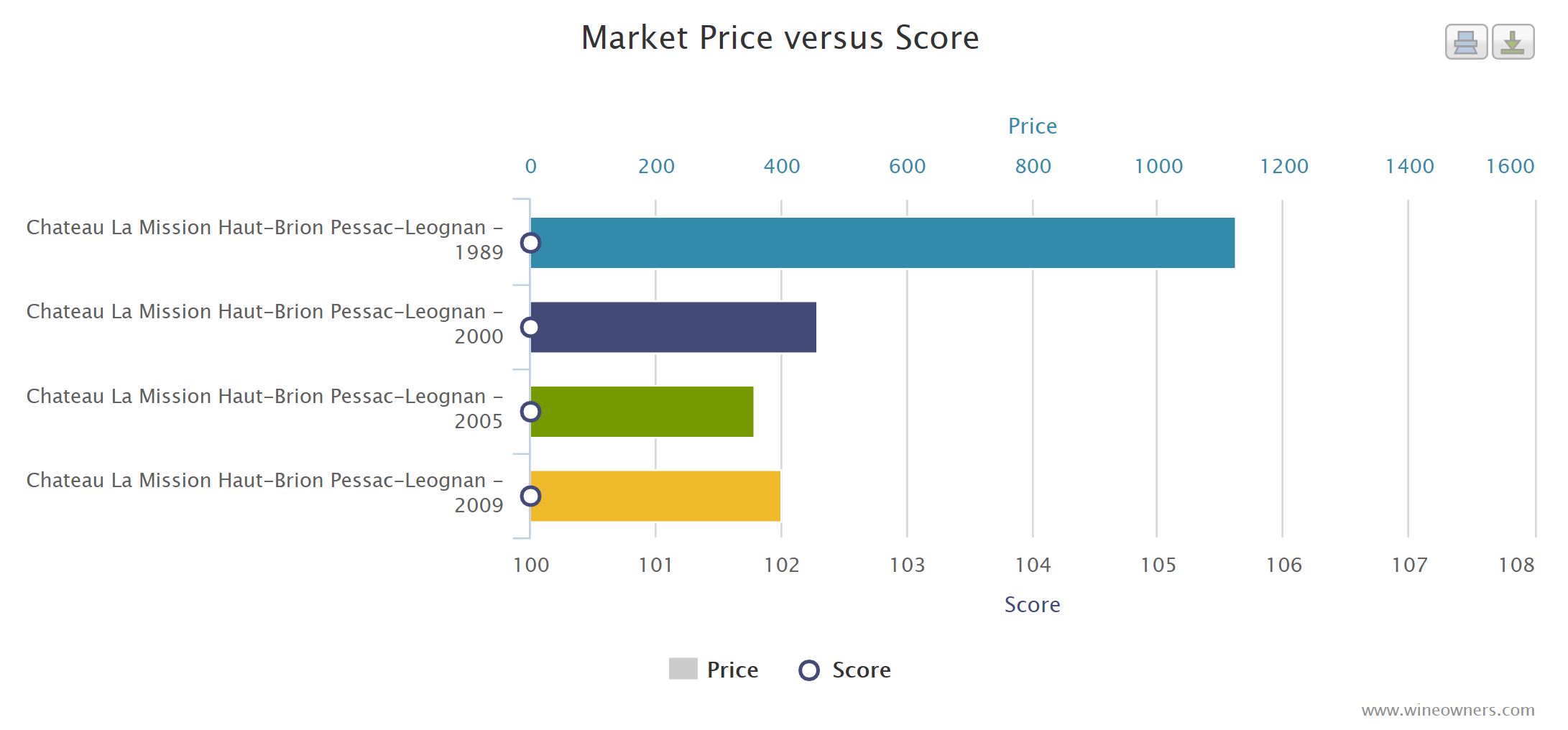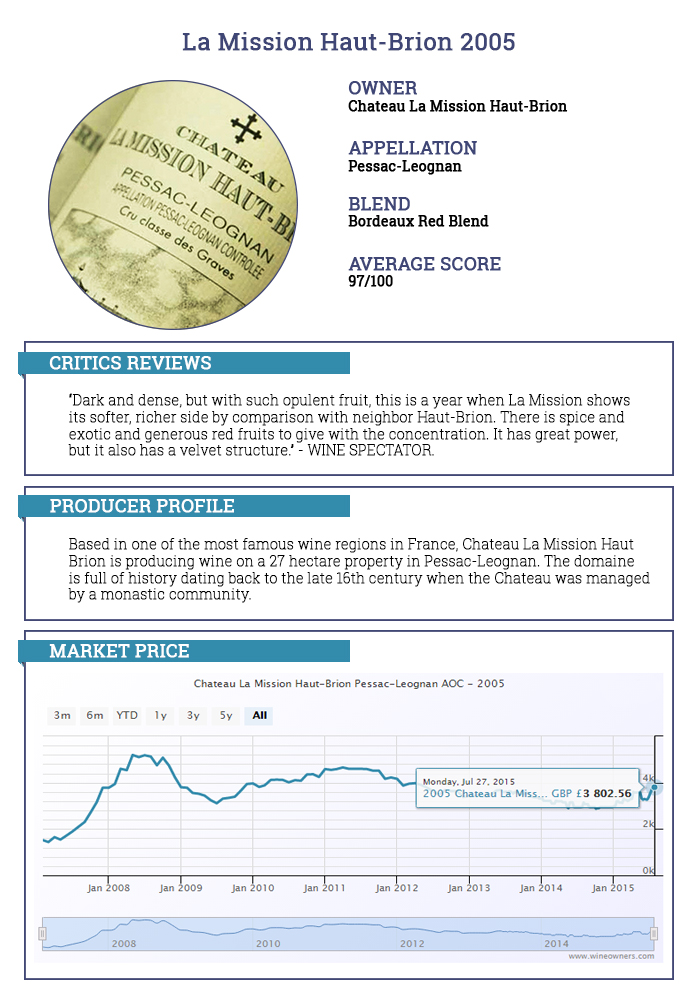by Wine Owners
Posted on 2018-05-17
An overlooked example of value for money here from the 100 point La Mission 2005. Compared to Domaine Clarence Dillon stablemate Haut-Brion, and the rest of the 2005 First Growths, 2005 La Mission is a clear winner in terms of value as is eminently clear from relative value analysis. The only other 100 point wine on the whole left bank is Haut-Brion, which trades at around £6,500. The other Mouton will cost £5,250, Latour £6,600, and Margaux £6,100, all on 98 points, while Lafite lags behind them all in relative terms, commanding £7,700 for 96 points.
Compared to other 100 point La Missions over the year, the 2005 wins out on relative value as well. Whether any of the 2009, 2005 and 2000 will hit the price highs of the legendary 1989 is a subject on which the verdict is very much out, and will depend on how reputation of the vintages develops. Nevertheless, all three look like relatively sound buys, and the 2005 at the offer price just beats the rest (assuming they can be bought at market level).

“The 2005 La Mission Haut-Brion is pure perfection. It has an absolutely extraordinary nose of sweet blackberries, cassis and spring flowers with some underlying minerality, a full-bodied mouthfeel, gorgeously velvety tannins (which is unusual in this vintage) and a long, textured, multi-layered finish that must last 50+ seconds. This is a fabulous wine and a great effort from this hallowed terroir. Drink this modern-day legend over the next 30+ years. Only 5,500 cases were produced of this blend of 69% Merlot, 30% Cabernet Sauvignon and 1% Cabernet Franc.”
100 points, Robert Parker
La Mission Haut-Brion 2005 is offered £4,300 on the Wine Owners Exchange (£4,435 including fees)
by Wine Owners
Posted on 2017-11-24
The Don, St Swithins Lane, London, a converted wine warehouse, was the venue for one of Wine Owners tasting evenings offered to its members – Trial and Terroir Dinner based upon the 2011 Bordeaux vintage. The evening was conducted in one of the Don’s private rooms with an earthy dinner by head chef Frederick Forster.
Lionel Dougnac, buying director for De Luze & Fils, one of Bordeaux’s most influential negotiants, helped us navigate the properties surrounding the waters of the Gironde estuary. Lionel has been in the Bordeaux trade for over 20 years, specialising in buying classified growths. He has also worked for the top barrel-maker in France. Oaking became an interesting discussion point half way through the evening.

The focus for the evening was to explore the concept of terroir through the different wines presented during the evening from the 2011 vintage in Bordeaux. A vintage which left many enthusiasts wondering if the so-called ‘harlequin’ year could justify its high prices at primeur. Not surprisingly, there was immediately an exchange over what terroir might mean and during the evening there was plenty of opportunity to plumb the depths of this compelling subject. Lionel was quick to point out that, in his view, terroir was not just about the weather and soils but also included other factors, and even the ambitions of the domain owner.
2011: for those that might have forgotten, it was an unusual year by any standard. The year started with a massive water deficiency in First floors, and an unusually warm and protracted Spring. This meant that the vines were well in advance over the average year. Average temperatures during this period were close to if not in excess of any records previously recorded. It culminated in two extremely hot days in June where the temperature exceed 40°C. Some exposed bunches of grapes, especially on gravel soils, were scorched and losses were considerable, as much as 20% of the crop in some instances. If vignerons were concerned that any continuation of the drought would decimate whatever crop remained they needn’t have worried as damp, cool weather set in for much of July, followed by a very hot August. The heat precipitated some substantial downbursts and overall precipitation was above average for the period. An Indian summer followed which provided optimum conditions for the harvest in September. A series of circumstances which profited the white wines of the region but the red wines were heterogeneous.

L’Evangile vs Vieux Château Certan: the expression of the two first wines on offer provided an interesting contrast. The owners at VCC, the Thienpont family since 1924, have always worn their heart on their sleeve combined with an increasingly obsessive focus on managing First floor at a micro level of geography – and an ambition to let the terroir speak for itself using minimum intervention in the wine making. L’Evangile, now wholly owned by Domaines Barons de Rothschild since 1999 (they had earlier acquired a majority a shareholding) is a neighbour from ‘Haut-Pomerol’ with an ambition to become one of the top Pomerol estates. The latter’s substantially higher Merlot in the blend offered a very round and pleasing profile – a whopping 94%, leaving little room for their Cabernet Franc. It was very elegant and restrained which contrasted with the beautifully defined structure of VCC. There were pleasing elements in both wines. Interestingly, guests were not to be tempted by the more voluptuous offer and unanimously preferred the ‘aesthetic values’ expressed in Vieux Château Certan 2011.
In Pessac, the contrast was even more stark. Haut-Bailly, as always, attractive and feminine, seduced much of the company with its approachable elegance based on a more merlotised style than usual - a statistical recognition, if nothing else, that its Cabernet Sauvignon suffered that year. The Cabernet Franc, already on the way out at the domain, hardly got more than a top-up role. Haut-Bailly have always acknowledged that their terroir has issues under dry conditions such as those experienced in 2011. La Mission Haut-Brion was altogether more muscular and intense. It possessed a complex tension which will be years in its evolution. Lionel had obviously selected the wines he felt would give us more to ponder. We digressed into a conversation about how artists’ materials are perhaps the elements of physical terroir; that artistic genius is the inspiration, imagination and ambition of an estate’s terroir interpreted by the owner. Whatever the canvas that year, Wine Owners terroirists’ marginally preferred the more ‘traditional’ yet polished properties expressed in the intense muscularity of La Mission Haut-Brion 2011.
The grand estates of Pauillac were represented by Pontet-Canet and Château Pichon-Longueville Baron. This gave us an opportunity to discuss the influence of biodynamic viticulture in the region and its impact on the wines of Pontet-Canet. Clearly something had separated the processes of these two estates which are largely comparable in terms of size and varieties. When it came down to it, Pichon Baron managed 82% Cabernet Sauvignon in their blend, whilst Pontet-Canet a mere 60%. Yields were disparate too – 39% in the case of Pichon Baron whilst at Pontet-Canet it was 32%. It’s worth just quoting from the specification sheet of Pichon-Baron 2011 to understand properly the enormous lengths châteaux had to go to preserve the quality in the bottle:
“Bespoke grape picking: the grapes were picked and brought in the vat-house plot by plot, in order of maturity, with particular attention to selection on the plots. Sorting in the vat-house was highly meticulous [their bold] keeping only the very best grapes. The grapes were sorted twice, both before and after de-stemming. Once de-stemmed, the selection of the grapes was fine tuned on two sorting lines, one manual and one using optic systems.”
This extensive and costly work appears to have been justified as the assembled company substantially preferred this wine. Perhaps the more laissez-faire practices of biodynamics don’t favour complicated years albeit it may be a more ‘authentic’ product.
Our final flight of the evening ended with a cheese plate and perhaps two of the most interesting wines of the evening – Chateaux Montrose and Calon-Ségur. Both estates in their own ways have seen major upheavals over the last 5-10 years. One could even be forgiven for thinking that terroir might the servant of the ambition of the two new owners. Certainly, the Bouygues have invested colossal sums in an estate which they were always destined to own. The recent vintages have all demonstrated that their terroir has justified the trust of its billionaire owners producing wonderful wines in supposedly less good vintages. 2011 was no exception. Montrose’s enhanced ‘environmental responsibility’ which the Bouygues have brought to the estate extends the work of one of its founders, Mathieu Dollfus, who established a programme of social care for his workers building them free housing in the ‘Montrose village’, included them in profit sharing and even offered free health care – making ‘unique contributions to the community’ of Saint-Estèphe. The windmill which stands on the property is a ‘symbol’ of his tenure and his fight against phylloxera – the windmill drew up water which flooded First floors – a practice which had some success in reducing the disease at the time. At Calon-Ségur, despite the death of its owner at harvest time, pulled off a stunning wine - contradicting received wisdom about yields (the estate had one of the largest yields of all the wines tasted) and demonstrated that even in turbulent times estates can pull something out of a hat. Triumph in adversity is part of the story of Bordeaux. Opinion was equally divided on their relative merits.
Lionel’s deft commentary on the wines permitted discussions on all other matters of interest to the guests. This wasn’t just a working evening – although there was much to delve into.
The evening conversation turned to a brief but informative discussion about the commercial prospects of ‘La Place’, advantages or otherwise of buying en primeur and discussions on some practices of specific châteaux to release wines as ‘library’ wines after primeur campaigns - subjects which Lionel was uniquely qualified to explain.
For those still with the will to carry on tasting there was ample opportunity with additional samples as backup. Overall, the unscientific assessment was that there were 3 stand-out wines – La Mission Haut-Brion 2011, Montrose 2011 and Vieux Château Certan 2011.
Broader definitions of terroir escape the confines of the tightly worded official description. The Australian economist David Throsby outlined the concept of a ‘cultural good’ (in his seminal book Economics and Culture, 2001) which might fit better to the breadth of considerations Lionel managed to convey during the evening. Throsby’s thesis is that a person’s preference for something would be based upon the characteristics of the good which contribute to its cultural value. Some of these are highlighted above in quotes but, in summary, they include aesthetic properties eg elegance and balance; spiritual value – emotional and inspirational attachment; environmental which includes PDO (L’Appellation d’origine protégée) and environmental responsibility; historical – evolution and tradition; symbolic, such as the name of ‘Bordeaux’ itself and what it inspires and among others one might conjure; and authenticity which is embodied in the unique character of a wine drawn from the local area where it is produced.
The WineOwners Trial and Terroir Dinner managed to elucidate these concepts and more.
by Wine Owners
Posted on 2015-07-28


